Ionisation enthalpy (ΔtHlinkJmol−1) for the elements of group-13 follows the order
B>AI>Ga>In>TI
B<AI<Ga<In<TI
B<AI>Ga<In>TI
B>AI<Ga>In<TI
The correct Answer is:D
To determine the order of ionization enthalpy for the elements of Group 13, we need to analyze the trends in atomic size and the effective nuclear charge experienced by the outermost electrons as we move down the group. Here’s a step-by-step solution:
Step 1: Identify the Elements in Group 13
Group 13 elements include:
- Boron (B)
- Aluminium (Al)
- Gallium (Ga)
- Indium (In)
- Thallium (Tl)
Step 2: Understand Ionization Enthalpy
Ionization enthalpy (ΔtH) is the energy required to remove an electron from the outermost shell of an isolated gaseous atom. Generally, ionization enthalpy decreases down a group due to the increase in atomic size and the decrease in effective nuclear charge felt by the outermost electrons.
Step 3: Analyze the Trend Down the Group
As we move from Boron to Thallium:
- The atomic size increases due to the addition of electron shells.
- The outermost electrons are further from the nucleus, leading to weaker attraction and easier removal.
Step 4: Consider Exceptions in Group 13
While the general trend suggests that ionization enthalpy should decrease down the group, there are exceptions:
- Gallium (Ga) has a higher ionization enthalpy than Aluminium (Al) despite being below it in the group. This is due to the presence of d-electrons in Ga, which increase the effective nuclear charge and result in a smaller atomic size compared to Al.
- Thallium (Tl) has a higher ionization enthalpy than Indium (In) due to the poor shielding effect of the f-electrons, which leads to a stronger attraction of the outermost electrons in Tl compared to In.
Step 5: Establish the Correct Order
Considering the above points, the correct order of ionization enthalpy for Group 13 elements is:
1. Boron (B) - highest
2. Gallium (Ga)
3. Aluminium (Al)
4. Thallium (Tl)
5. Indium (In) - lowest
Thus, the order is: B > Ga > Al > Tl > In.
Final Answer
The correct order of ionization enthalpy for the elements of Group 13 is:
Boron > Gallium > Aluminium > Thallium > Indium.
---
Group 13 elements include:
- Boron (B)
- Aluminium (Al)
- Gallium (Ga)
- Indium (In)
- Thallium (Tl)
Ionization enthalpy (ΔtH) is the energy required to remove an electron from the outermost shell of an isolated gaseous atom. Generally, ionization enthalpy decreases down a group due to the increase in atomic size and the decrease in effective nuclear charge felt by the outermost electrons.
As we move from Boron to Thallium:
- The atomic size increases due to the addition of electron shells.
- The outermost electrons are further from the nucleus, leading to weaker attraction and easier removal.
While the general trend suggests that ionization enthalpy should decrease down the group, there are exceptions:
- Gallium (Ga) has a higher ionization enthalpy than Aluminium (Al) despite being below it in the group. This is due to the presence of d-electrons in Ga, which increase the effective nuclear charge and result in a smaller atomic size compared to Al.
- Thallium (Tl) has a higher ionization enthalpy than Indium (In) due to the poor shielding effect of the f-electrons, which leads to a stronger attraction of the outermost electrons in Tl compared to In.
Considering the above points, the correct order of ionization enthalpy for Group 13 elements is:
1. Boron (B) - highest
2. Gallium (Ga)
3. Aluminium (Al)
4. Thallium (Tl)
5. Indium (In) - lowest
The correct order of ionization enthalpy for the elements of Group 13 is:
Boron > Gallium > Aluminium > Thallium > Indium.
Topper's Solved these Questions
- THE P-BLOCK ELEMENTSBOOK - NCERT FINGERTPS ENGLISHCHAPTER - THE P-BLOCK ELEMENTSEXERCISE - ASSERTION & REASON
15 Videos
- THE P-BLOCK ELEMENTSBOOK - NCERT FINGERTPS ENGLISHCHAPTER - THE P-BLOCK ELEMENTSEXERCISE - Group 13 Elements - The Boron Family
23 Videos
- THE P-BLOCK ELEMENTSBOOK - NCERT FINGERTPS ENGLISHCHAPTER - THE P-BLOCK ELEMENTSEXERCISE - HIGHER ORDER THINKING SKILLS
9 Videos
- STRUCTURE OF ATOM BOOK - NCERT FINGERTPS ENGLISHCHAPTER - STRUCTURE OF ATOM EXERCISE - Assertion And Reason
15 Videos
- THE S-BLOCK ELEMENTSBOOK - NCERT FINGERTPS ENGLISHCHAPTER - THE S-BLOCK ELEMENTSEXERCISE - Assertion And Reason
15 Videos
Similar Questions
Ionisation enthalpy (ΔiH kJ mol−1) for the elements of group 13 follows the order.
View SolutionThe first ionisation enthalpy values (in kJ mol−1) of group 13 elements are

How would you explain this deviation from the general , trend?
View SolutionThe first (ΔH1) and second (ΔH2) ionisation enthalpies (in kJmol−1) and the (ΔHeg) electron gain enthalpy (in kJmol−1) of a elements are given below:
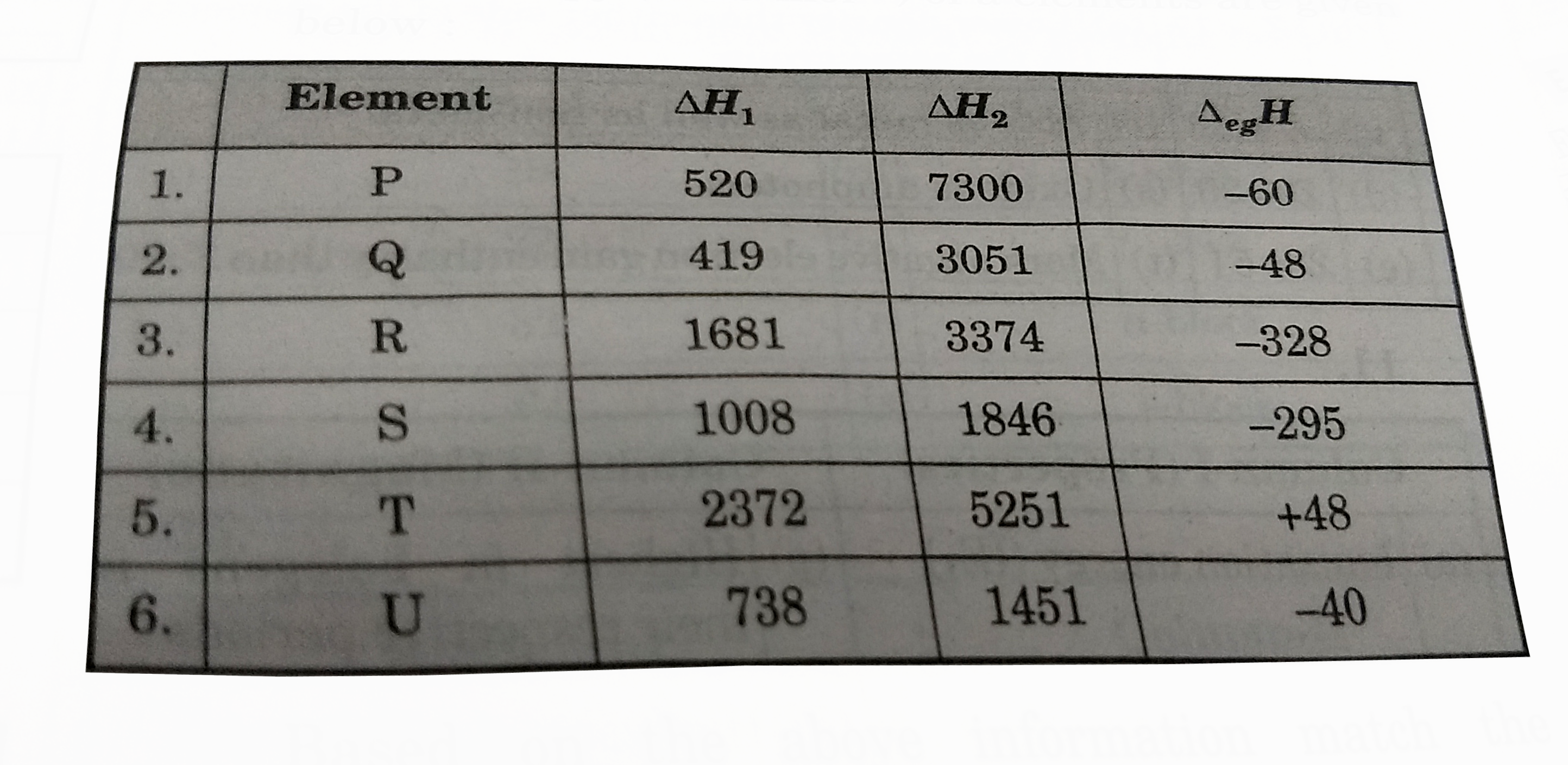
Based on the above information match the following columns.
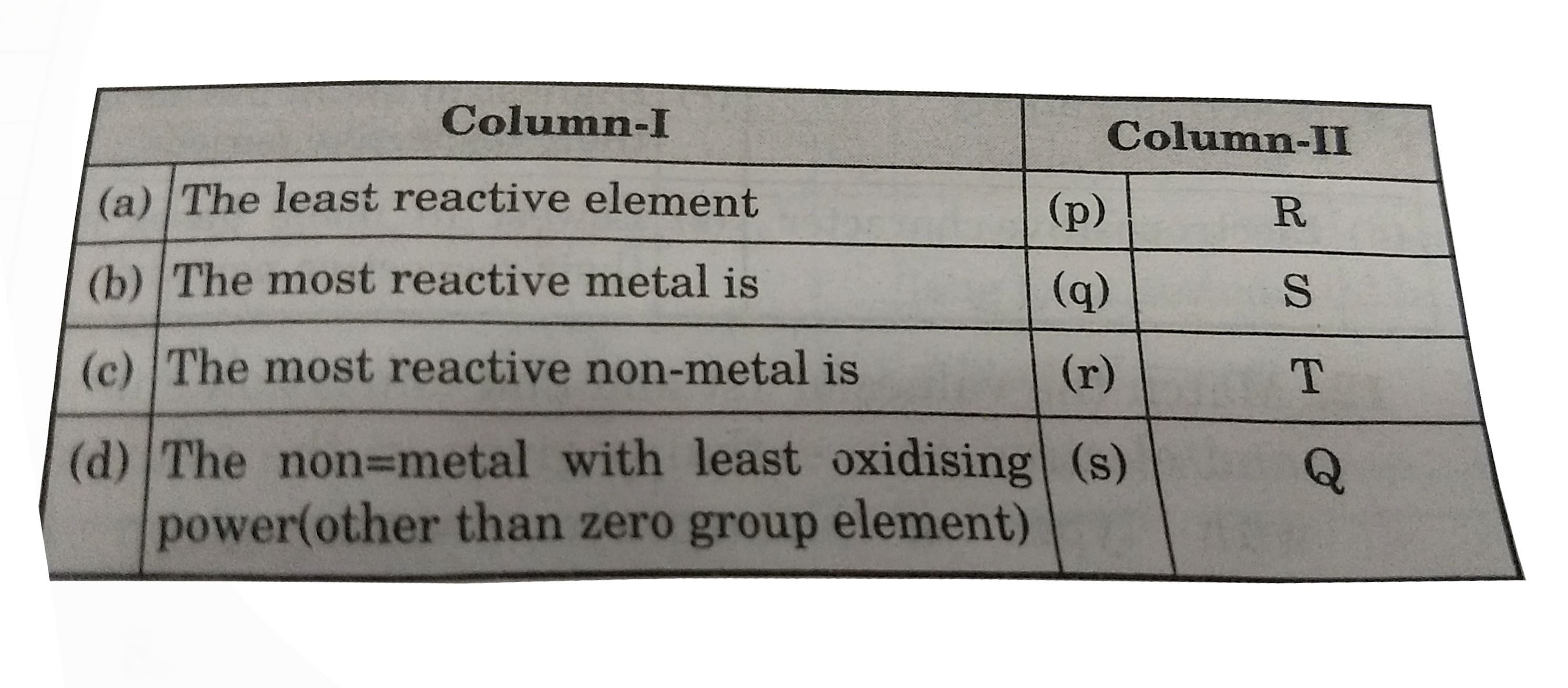
View SolutionThe first (Δi,H1) and the second (Δ,H2) ionisation enthalpies (in kJ mol−1 ) and the (ΔegH) electron gain enthalpy (in kJ mol−1 ) of a few elements are given below :
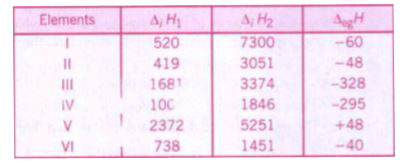
Which of the above elements is likely to be :
the least reactive element?
View SolutionThe first (Δi,H1) and the second (Δ,H2) ionisation enthalpies (in kJ mol−1 ) and the (ΔegH) electron gain enthalpy (in kJ mol−1 ) of a few elements are given below :
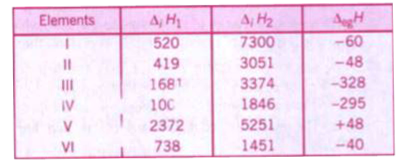
Which of the above elements is likely to be :
a reactive metal
View SolutionThe first ionisation enthalpy (ΔiHo−) values of the third period elements, Na,Mg and Si are respectively 496,737 and 786kJmol−1. Predict whether the first ΔiHo− value for Al will be more close to 575 or 760kJmol−1? Justify your answer.
View SolutionThe first ionization enthalpy (ΔtH) values of the third period elements, Na,Mg and Si are respectively 496, 737 and 786kJmol−1. Predict whether the first ΔtH valye for Al will be more close to 575 or 760kJmol−1? Justify your answer.
View SolutionThe first (ΔiH1) and second (ΔiH2) ionisation enthalpies (inkJmol−1) and the (ΔegHө) electron gain enthalpy (inkJmol−1) of a few elements are given below:
Elements(ΔiH1)(ΔiH2)ΔegHөI5207300−60II4193051−48III16813374−328IV10081846−295V23725251+48VI7381451−40
Which of the above elements is likely to be
a. the least reactive element.
b. the most reactive metal.
c. the most reactive non-metal.
d. the least reactive non-metal.
e. the metal which can form a stable binary halide of the formula MX2 (X=halogen).
f. the metal which can form a predominantly stable covalent halide of the formula MX(X=halogen).
View SolutionFirst and second ionisation enthalpies(in KJ/mol) of few elements are given below:
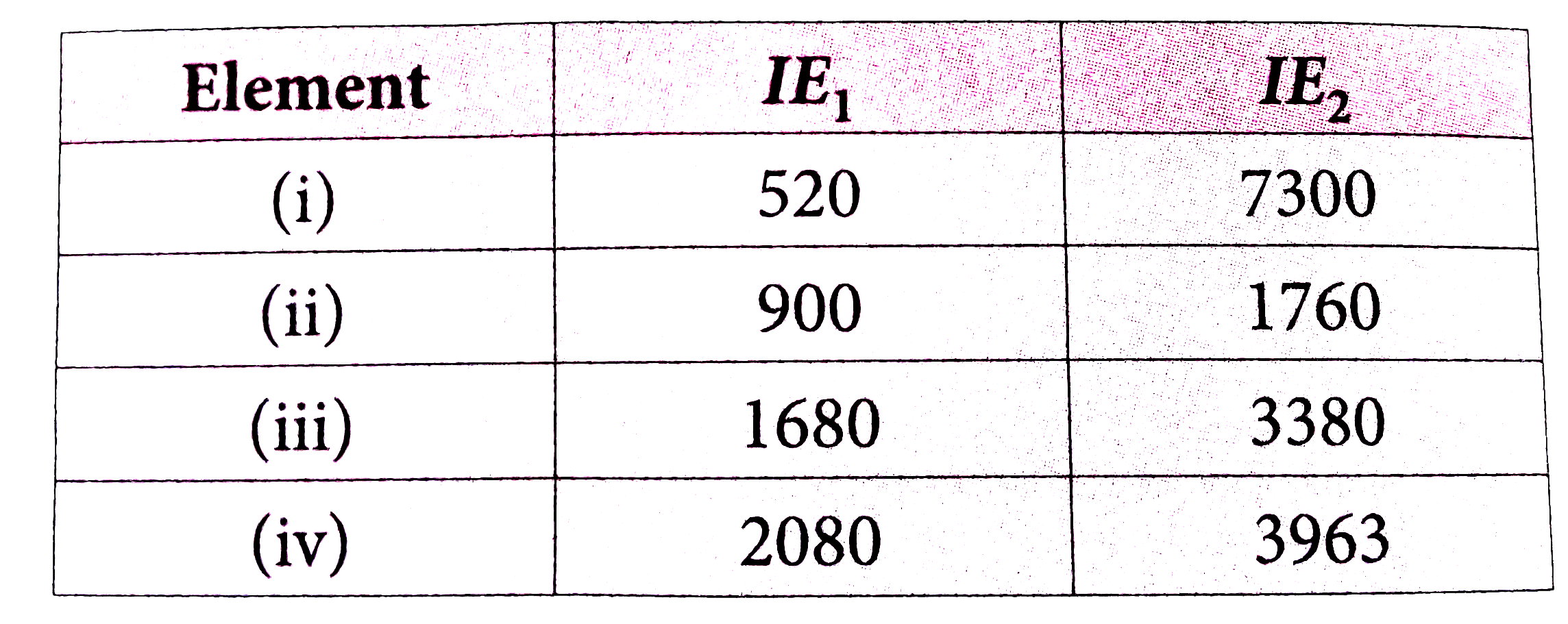
Which of the above elements will form halides with formula MX2?
View SolutionIonisation of energy Fɵ is 320kJmol−1. The electronic gain enthalpy of fluorine would be
View Solution
